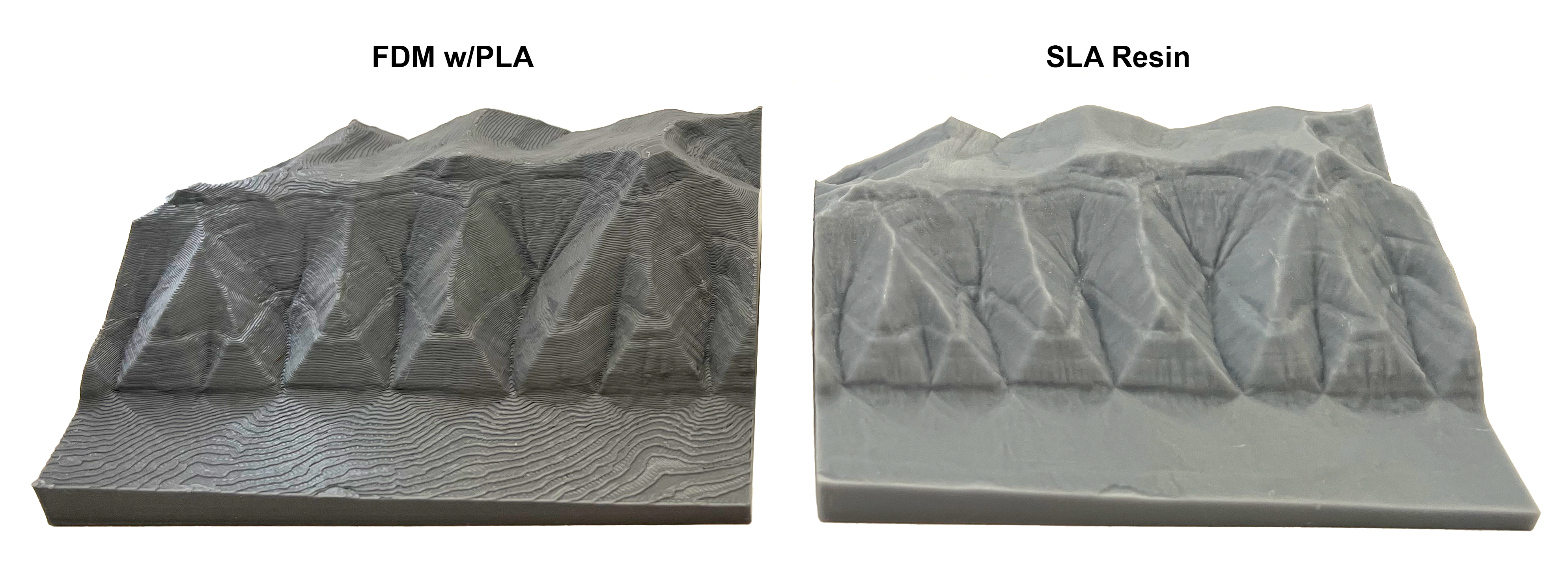Have you ever wanted to make a 3D print of your favorite mountain peak, city-scape, or tourist destination? OpenTopography's video tutorial demonstrates how to prepare a digital elevation model (DEM) for 3D printing. Each software package in the tutorial is freely available for download. In the tutorial, we describe step-by-step how to create the standard triangle language (STL) file that is commonly used in 3D printing. We use the DEMto3D plugin in QGIS to generate the STL file, which can then be viewed and modified using the 3D Builder software. You can find a number of pre-made STL files for 3D printing on our OpenLandform Catalog.
This YouTube video tutorial explains how to create a 3D printable model from a DEM downloaded from OpenTopography:
3D Printing Terrain Workflow
You can find topography data via OpenTopography's portal to download high resolution digital elevation models (DEMs). 3D prints can be made using a digital terrain model (DTM), which depicts just the bare Earth surface, or a digital surface model (DSM), which depicts vegetation, buildings, and other structures at Earth's surface. DTMs are preferable when printing topographic landforms, and DSMs are preferable when printing urban environments.
Open the DEM in QGIS and install the "DEMto3D" plugin. This plugin will allow you to select the print extent of your 3D model, the print spacing, the dimensions/scale, the vertical exaggeration, and the model base thickness. The plugin then exports and creates a STL file, which can be opened and viewed in software such as 3D Builder. This software can also be used to engrave the name of the location/landform into the 3D print or reduce/expand the height of the base.
The STL file is then ready to be imported into your 3D printer software and printed. If you do not have access to a 3D printer, there are a variety of websites that provide 3D printing services such as Craftcloud, 3D Experience Marketplace, and Treatstock.
 |
 |
 |
| Download DEM | Generate STL file in QGIS | Print using 3D printer |
The above print of the Yakima River, WA was printed on a MakerBot Replicator+ 3D printer using PLA filament. Extrusion-based 3D printers like this will naturally produce visible 'layer lines' on the final product.
Common Types of 3D Printing
| Fused Depositional Modeling (FDM) | Stereolithography (SLA) | Selective Laser Sintering (SLS) |
|---|---|---|
 Sunset Crater, AZ |
 Garlock Fault Zone, Ridgecrest, CA |
 Dragon's Back Ridge, San Andreas Fault, CA |
|
|
The type of 3D printing used will impact the details of the topography that can be conveyed. FDM prints can effectively capture large-scale topographic landforms and features. As a nozzle extrudes each individual print layer, FDM prints have 'layer lines' that are reminiscent of contour intervals. These lines may be of benefit if working to translate 2D contour maps to a 3D understanding of the landscape. Both SLA and SLS printing methods are able to capture exceptionally fine detail, highlighting smaller scale features of the topography. This increased detail, though, comes at a higher production cost.

Comparison of 3D prints of Manti-La Sal National Forest, Utah made using FDM printing with PLA filament (left) and SLA resin printing (right). The FDM print shows less detail and has distinct layer lines, but is significantly cheaper to produce. The SLA resin print captures all the fine detail of the topography but can be comparatively 5x as expensive to produce when using an online printing service.
3D Printing Examples
Multiple schools and organizations have already created 3D models from elevation data hosted by OpenTopography. For example, students at the Indiana School for the Blind and Visually Impaired can tactilely explore their campus with this 3D printed map of their school.

Pre-made STL files are available to download for the majority of landforms on our OpenLandform Catalog. Below are examples of prints using these files.

|

|
| Lateral moraines of the Teton Front Range, Wyoming. FDM print with PLA filament. | Landslide in the Alaska Range along Denali-Totschunda Fault System, Alaska. FDM print with PLA filament. |
